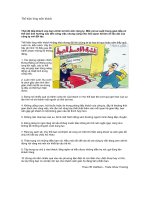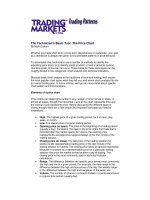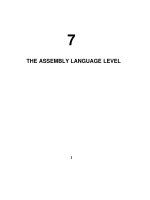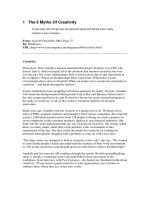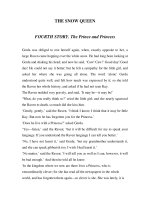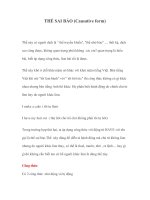Tài liệu The Technician''''s Basic Tool The Price Chart - Sri 0028 -(pdf) pdf
Bạn đang xem bản rút gọn của tài liệu. Xem và tải ngay bản đầy đủ của tài liệu tại đây (136.45 KB, 9 trang )
The Technician's Basic Tool: The Price Chart
By Mark Etzkorn
Whether you trade short-term or long-term, discretionary or systematic, your goal
as a technician is always the same: to find profitable patterns in price behavior.
To accomplish this, technicians use a number of methods to identify the
prevailing price trend, or to identify points at which a trend is about to reverse
(the time scale, of course, can vary). These basis for these techniques can be
roughly divided in two categories: chart analysis and technical indicators.
Because basic chart analysis is the backbone of technical trading, we'll explain
the most popular chart types, what they tell you, and where chart analysis fits into
an overall trading plan. In future articles, we'll go into more detail about specific
chart pattern and trend analysis.
Elements of a price chart
Price charts can depict price action in any number of time frames or styles. In
almost all cases, though, the horizontal x-axis of the chart represents time and
the vertical y-axis represents price. Before discussing the different types of
charts, though, there are a few simple, but important concepts you need to
understand.
•
High.
The highest price of a given trading period, be it an hour, day,
week, or month.
•
Low.
The lowest price of a given trading period.
•
Opening price (or open).
The price at the beginning of a trading period
(usually a day). For stocks, the open is the price of the first trade that is
recorded after the market opens; for futures, the opening price
represents the average price (approximately) of the first minute of the
trading session.
•
Closing price (or close).
The last price of the trading session (for
stocks) or the representative trading price of the last minute of the
trading session for futures. The closing price takes on special importance
because it functions as a representative price for a particular trading
session--the price the market arrived at after a day of trading. The
closing price is the most commonly used in technical indicator
calculations.
•
Range.
The difference between two specific price levels, most commonly
the high and low of a given period. For example, the daily range is the
difference between the high and low prices of the day, the weekly range
is the difference between the high and low prices of the week, etc.
•
Volume.
The number of shares or contracts traded in a particular market
in a given time period (usually day).
•
Open interest.
The number of open trades in a particular market. Both
volume and open interest provide measures of liquidity, i.e., the amount
of trading activity in a market, and thereby the ease with which you can
get in and out of it. Liquid markets are generally less risky and easier to
trade than illiquid markets because they are less prone to wild swings or
gaps between prices. (However, some traders use strategies specifically
designed to profit from the volatility in illiquid markets.)
The bar chart
The most popular type of price chart is the daily bar chart, which summarizes the
price action of a trading session as a vertical line, or bar, ranging from the high
price to the low price. The closing price appears as a horizontal hash mark
extending out from the right of the bar and the opening price appears as a
horizontal hash mark extending out from the left of the bar (sometimes the
opening price is omitted).
Figure 1. A price bar from a daily bar chart.
Figure 1 depicts a typical price bar. A daily bar chart, for example, would
represent each day's trading with an individual bar: The high of the bar would be
the high price of the day, the low of the bar would be the low price of day, and the
left and right hash marks would be the opening and closing prices of the day,
respectively. The price bar succinctly summarizes the day's trading activity: the
daily range (from high to low), where the market opened, and where it closed.
Figure 2 shows a daily bar chart for Dell computer.
Figure 2. Daily bar chart, Dell Computer.
Time frames
Price charts can be constructed in virtually any time frame: minutes, hours, days,
weeks, months, quarters, years, etc. A weekly bar chart, for example, would be
constructed exactly the same as the daily bar chart except that it would use the
high and low prices of the week rather than the high and low prices of a day.
The opening and closing prices for a weekly chart are simply the opening price
for the first trading day of the week (usually Monday, unless there is a holiday)
and the closing price of the last day of the week (usually Friday, unless there is a
holiday).
Figure 3. Weekly bar chart, Dell Computer.
Similarly, each bar on a monthly bar chart would use the opening price of the first
day of the trading month and the closing price of the last day of the trading
month. Figure 3 shows a weekly bar chart that also encompasses the time period
captured in the daily chart shown in Figure 2. Figure 4 shows a monthly bar chart
for the same stock.
Figure 4. Monthly bar chart, Dell Computer.
An hourly chart, by comparison, uses the high and low prices of each hour of a
trading session to define price bars, and a five-minute chart uses the high and
low prices of each five-minute period. For such intraday charts, opening and
closing prices are often omitted (since, obviously, there are no official opens or
closes reported), or the first recorded price of a particular period might be used
as the opening price and the last recorded price of the period as the closing
price. Figure 3.5 shows a five-minute chart.
Figure 5. Five-minute bar chart, June ’99 T-bond futures. Note: Bars are tightly compressed.
The smallest time frame chart that can be constructed is a tick chart, which
creates a data point for every trade reported in a market. (Tick refers to the
minimum price move in any market.)
Looking at price charts of varying time frames allows you to focus on as short or
long a time period as you want. Longer-term price charts also enable you to
provide a context for the price action on shorter-term charts. A trade signal
generated from a pattern on a short-term chart may be supported or negated by
the activity on the long-term chart. A short-term buy signal might be ignored, for
example, if the long-term chart shows a strong downtrend is in force.
Other types of charts
Bar charts are the most widely used chart type, but they are not your only choice
as a technician. Other chart styles give you different perspectives on price action.
Line (close-only) charts
The line chart plots only the closing prices from each trading session, essentially
creating a simplified version of the standard bar chart. Figure 6 shows a close-
only version of the price data from Figure 2. Some charting software will allow
you to create line charts using the high price, low price, or average price from a
particular bar instead of the closing price, but the closing price is most commonly
used in technical analysis.
